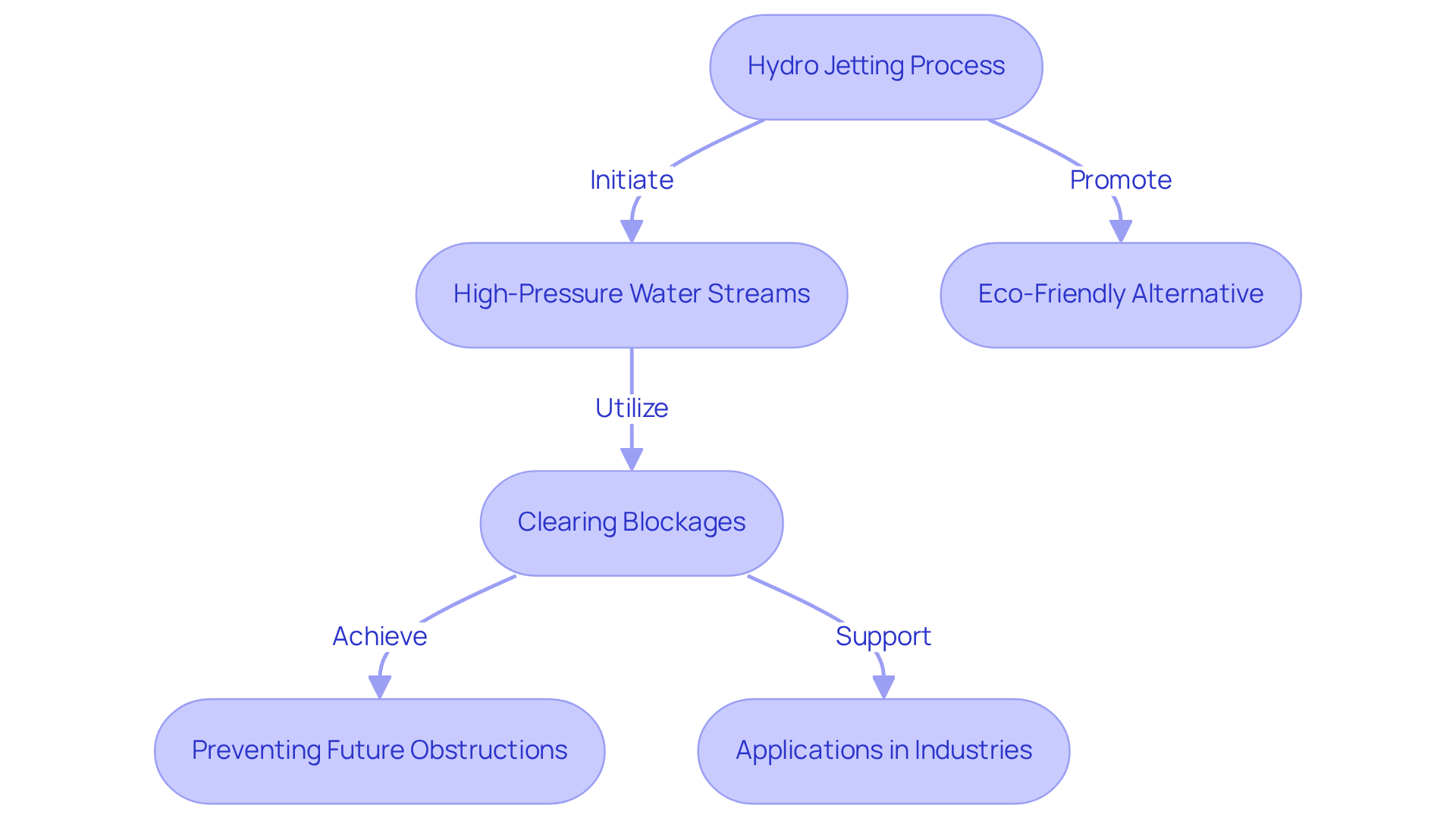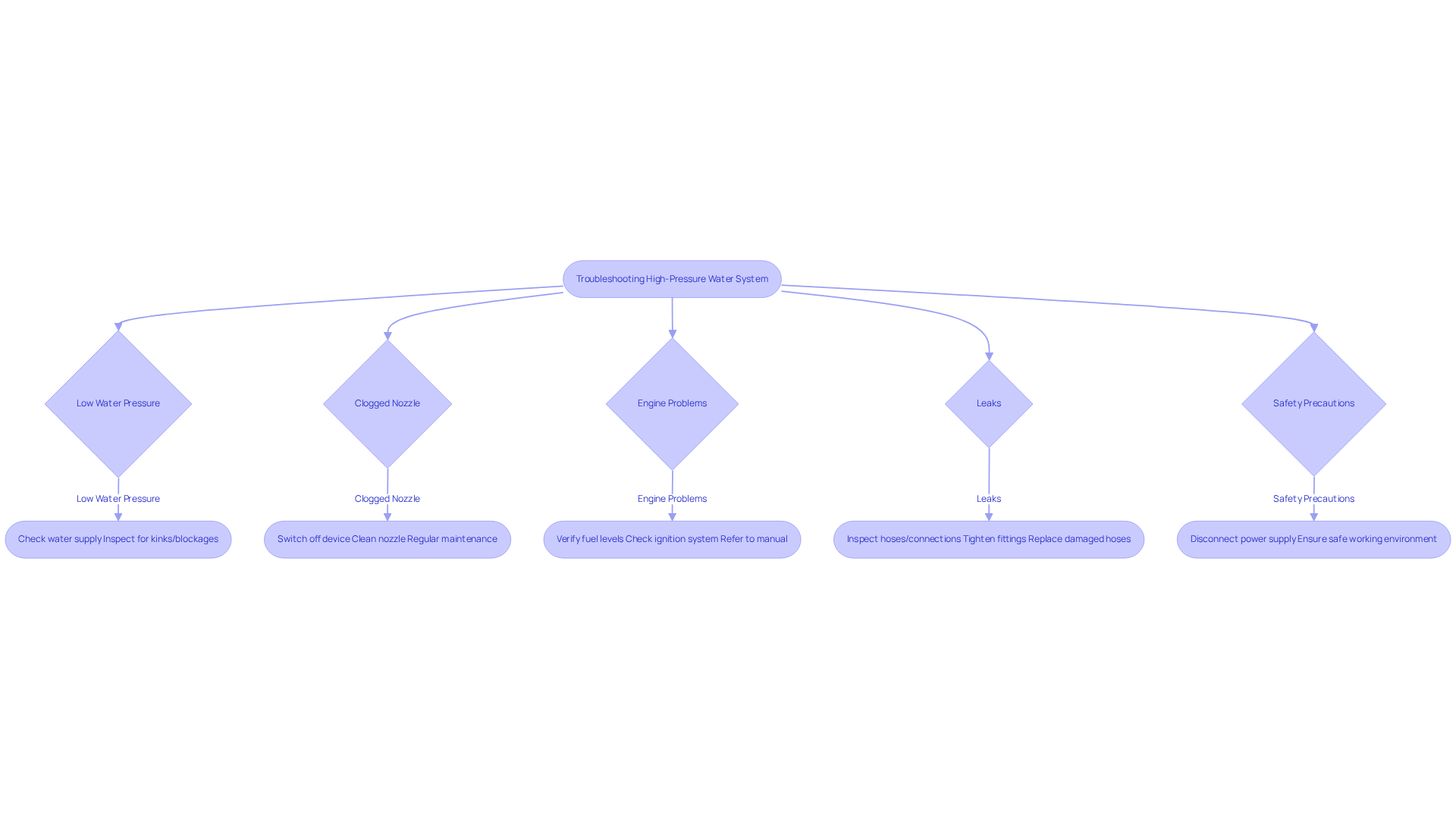Overview
This article presents an authoritative step-by-step guide for renting a hydro jetting machine. It underscores the critical importance of:
- Assessing plumbing needs
- Understanding safety protocols
- Adhering to a structured rental process
By detailing essential considerations such as:
- Equipment inspection
- Rental requirements
- Common troubleshooting tips
The guide ensures that users are well-prepared for the effective operation and maintenance of the hydro jetting machine.
In addition, it emphasizes the reliability and quality of the equipment, showcasing how proper rental practices can lead to successful plumbing solutions. By following the outlined steps, users can maximize their experience and ensure that they are equipped to handle any challenges that may arise.
Furthermore, testimonials from satisfied customers highlight the effectiveness of these practices, reinforcing the value of being well-informed before renting.
Ultimately, this comprehensive guide serves as a vital resource for anyone looking to rent a hydro jetting machine. It encourages immediate engagement by prompting readers to assess their plumbing needs and consider the benefits of reliable equipment rental. Take action today and ensure you are fully prepared for your next plumbing project.
Key Highlights:
- Hydro jetting is an advanced plumbing technique using high-pressure water streams (3,000 to 4,000 psi) to clear blockages and maintain plumbing systems.
- The primary goal of hydro jetting is to prevent future blockages by thoroughly cleaning the inner surfaces of pipes.
- This method is particularly beneficial for maintaining sewer lines and is used in industries like food service and healthcare to meet sanitation standards.
- Hydro jetting is an eco-friendly alternative to chemical cleaners, reducing environmental harm while effectively addressing stubborn clogs.
- Key considerations before renting a hydro jetting machine include identifying plumbing needs, checking rental requirements, understanding safety protocols, reviewing rental terms, and inspecting the equipment.
- The rental process involves researching rental firms, contacting them for availability, making a reservation, picking up the equipment, receiving operating instructions, and ensuring safe transport.
- Common troubleshooting issues include low water pressure, clogged nozzles, engine problems, leaks, and the importance of safety precautions.
- Regular maintenance and inspections of hydro jetting machines are recommended to ensure optimal performance and longevity.
Introduction
In an age where plumbing issues can significantly disrupt daily life and business operations, hydro jetting stands out as a revolutionary solution. This high-pressure water cleaning technique not only effectively clears stubborn blockages but also plays a crucial role in maintaining the integrity of plumbing systems, thereby preventing future problems.
For those unfamiliar with this method, however, the process of renting a hydro jetting machine may appear daunting. What essential steps must be taken to ensure a successful rental experience? How can individuals maximize the benefits of this powerful tool? These are the key questions that will guide our exploration.
Understand Hydro Jetting: Definition and Purpose
Hydro flushing stands as an advanced plumbing technique, leveraging high-pressure water streams to effectively clear blockages and maintain plumbing systems. This method employs a specialized machine that propels water at pressures ranging from 3,000 to 4,000 psi through pipes, dislodging debris, grease, and other obstructions with remarkable efficiency. The primary objective of high-pressure water cleaning extends beyond merely removing current blockages; it aims to prevent future obstructions by thoroughly cleansing the inner surfaces of the pipes. This comprehensive cleaning approach proves particularly advantageous for maintaining sewer lines, ensuring optimal flow and significantly reducing the likelihood of recurring issues.
The practical applications of high-pressure water cleaning highlight its efficiency across various piping systems. For instance, industries in regulated sectors, such as food service and healthcare, utilize high-pressure water cleaning to meet stringent sanitation standards and prevent sewer backups. Routine maintenance through high-pressure water cleaning has been shown to extend the lifespan of piping systems, delivering substantial long-term financial benefits by minimizing the need for frequent repairs.
Experts in the pipe maintenance industry emphasize the advantages of high-pressure water cleaning, noting its status as a safe and eco-friendly alternative to chemical cleaners. By relying solely on water, high-pressure cleaning mitigates the harmful effects associated with harsh chemicals, making it an environmentally responsible choice for pipe maintenance. As the pipe maintenance sector evolves, an increasing number of professionals are adopting high-pressure water cleaning as a preferred method for pipe sanitation, recognizing its effectiveness in addressing stubborn clogs and ensuring optimal system performance.

Prepare for Rental: Key Considerations and Requirements
Before engaging in a hydro jetting machine rental, it is crucial to consider several key factors that ensure a successful experience.
- Identify Your Needs: Start by clearly defining the plumbing issues at hand. Evaluate the size and type of pipes that require cleaning to select the suitable equipment for high-pressure washing. Understanding your specific needs will guide you in making the right choice.
- Check Rental Requirements: Most rental companies require a valid ID, proof of insurance, and sometimes a deposit. Prepare these documents in advance to streamline the rental process and avoid any last-minute complications.
- Understand Safety Protocols: Familiarize yourself with the safety guidelines for operating high-pressure equipment. This includes wearing safety equipment such as gloves, goggles, and waterproof attire to mitigate hazards associated with high-pressure water cleaning. Prioritizing safety is essential for effective operation.
- Review Rental Terms: Carefully read the rental agreement to understand the terms. Pay close attention to the rental duration, costs, and any additional fees for late returns or damages. This diligence will help you avoid unexpected charges and ensure a smooth experience with your hydro jetting machine rental.
- Inspect the Equipment: Before accepting the rental, thoroughly examine the machine for any visible damage or missing components. Ensure that all hoses and nozzles are in good working condition to guarantee safe and effective operation. Taking these precautionary steps will enhance your confidence in the equipment's reliability.

Rent a Hydro Jetting Machine: Step-by-Step Process
To rent a hydro jetting machine, follow these steps:
- Research Rental Firms: Identify trustworthy equipment rental businesses in your vicinity, such as EZ Equipment Rental, recognized for its expertise in jetters and a broad selection of machinery including boom lifts, excavators, and forklifts. Their dedication to quality and dependability sets them apart in the industry.
- Contact the Rental Company: Reach out to inquire about the availability of high-pressure cleaning units, pricing, and specific models that suit your needs. In the Dallas-Fort Worth region, average costs for hydro jetting machine rental typically range from $350 per day to $5000 for monthly rentals.
- Make a Reservation: After selecting suitable equipment, reserve it for your desired rental period. Confirm the pickup date and time to ensure availability.
- Pick Up the Equipment: On the scheduled day, bring your identification and any required documents. Conduct a thorough inspection of the device before taking it home to ensure it meets your expectations.
- Receive Operating Instructions: Request a demonstration or detailed guidance from the rental staff on how to operate the water jet system safely and effectively. This ensures you comprehend its features and safety protocols.
- Transport the Equipment: Ensure you have a suitable vehicle for moving the jetter, as these machines can be heavy and require secure placement during transit to prevent damage.
Understanding the expenses linked to high-pressure water cleaning is essential for budgeting, with averages around $475 for professional services. Furthermore, consider preventative measures such as regular maintenance and inspections to ensure effective plumbing management.
Troubleshoot Common Issues: Tips for Successful Operation
Utilizing a high-pressure water system can present several challenges. Here are essential troubleshooting tips to effectively address common issues:
- Low Water Pressure: A drop in water pressure may signify an insufficient water supply or a kinked hose. Ensure the water source is adequate and inspect for any blockages in the hose. Operators typically employ a hydro jetting machine rental at pressures between 3000-4000 PSI, making it crucial to maintain this range for effective operation.
- Clogged Nozzle: A clogged nozzle can significantly impede performance. Always switch off the device and clean the nozzle thoroughly. Regular inspections and maintenance of the nozzle are vital for optimal functionality. As noted by US Jetting, "Hydro jetters benefit immensely from proactive maintenance checks."
- Engine Problems: If the engine fails to start, verify fuel levels and check the ignition system. Refer to the user manual for specific troubleshooting steps tailored to your device. Remember, if the pump freezes, it is critical not to start it to avoid severe damage.
- Leaks: Inspect hoses and connections for any signs of leaks. Tighten loose fittings and replace any damaged hoses immediately to prevent further complications. According to US Jetting, "Pump leaks can severely impact the performance of a jetter."
- Safety Precautions: Always prioritize safety when troubleshooting. Disconnect the power supply before conducting any maintenance or inspections on the equipment to ensure a safe working environment.
Regular maintenance is essential; technicians recommend that all jetting machines undergo inspections at least once a year, with more frequent checks based on usage. Promptly addressing issues can prevent costly repairs and ensure the longevity of your equipment.

Conclusion
Hydro jetting has become an essential technique in plumbing maintenance, providing an effective solution for clearing blockages and preventing future complications. This guide outlines the critical steps for renting a hydro jetting machine, underscoring the significance of thorough preparation, adherence to safety protocols, and a clear understanding of operational requirements. By approaching this process with diligence, individuals can fully leverage the advantages of hydro jetting to ensure their plumbing systems are maintained to the highest standards.
Key considerations include:
- Identifying specific plumbing needs
- Verifying rental requirements
- Understanding safety protocols
- Conducting equipment inspections
Furthermore, a detailed step-by-step process for renting the machine is provided, ensuring a seamless experience from initial research to operation. Addressing common troubleshooting issues further emphasizes the necessity of regular maintenance and proactive measures, which enhance the longevity and performance of hydro jetting equipment.
In conclusion, adopting hydro jetting as a preferred method for plumbing maintenance not only guarantees optimal system performance but also promotes a sustainable approach by minimizing reliance on chemical cleaners. As plumbing challenges continue to evolve, individuals and businesses are urged to explore the benefits of hydro jetting machine rentals and implement best practices that foster a cleaner, safer, and more efficient plumbing environment. Taking decisive action today can yield significant long-term advantages in preserving the integrity of plumbing systems.
Frequently Asked Questions
What is hydro jetting and what is its purpose?
Hydro jetting, also known as hydro flushing, is an advanced plumbing technique that uses high-pressure water streams to clear blockages and maintain plumbing systems. Its primary purpose is to remove current obstructions and prevent future blockages by thoroughly cleaning the inner surfaces of pipes.
How does hydro jetting work?
Hydro jetting works by using a specialized machine that propels water at pressures ranging from 3,000 to 4,000 psi through pipes. This high-pressure water dislodges debris, grease, and other obstructions efficiently.
What are the benefits of hydro jetting for plumbing systems?
The benefits of hydro jetting include preventing future blockages, maintaining optimal flow in sewer lines, extending the lifespan of piping systems, and delivering long-term financial savings by minimizing the need for frequent repairs.
In which industries is hydro jetting commonly used?
Hydro jetting is commonly used in regulated industries such as food service and healthcare, where it helps meet stringent sanitation standards and prevents sewer backups.
Is hydro jetting an environmentally friendly option?
Yes, hydro jetting is considered an eco-friendly alternative to chemical cleaners, as it relies solely on water, reducing the harmful effects associated with harsh chemicals.
Why is hydro jetting gaining popularity among pipe maintenance professionals?
Hydro jetting is gaining popularity because it effectively addresses stubborn clogs, ensures optimal system performance, and is recognized as a safe and environmentally responsible method for pipe sanitation.




